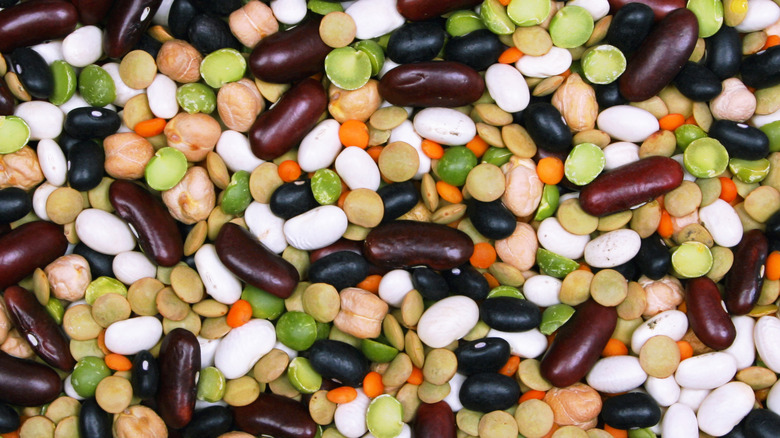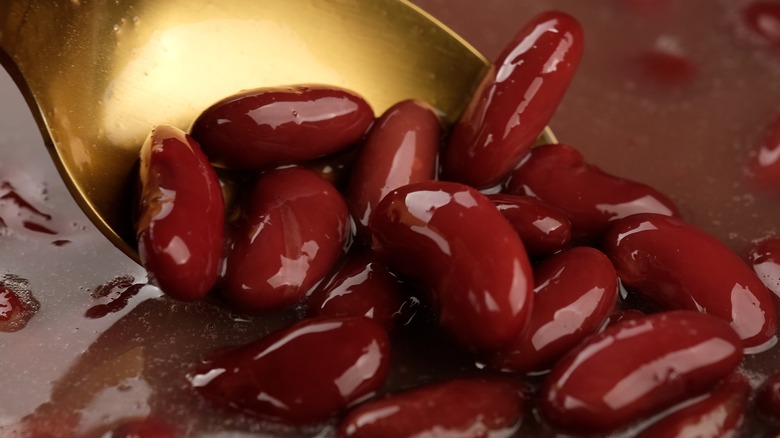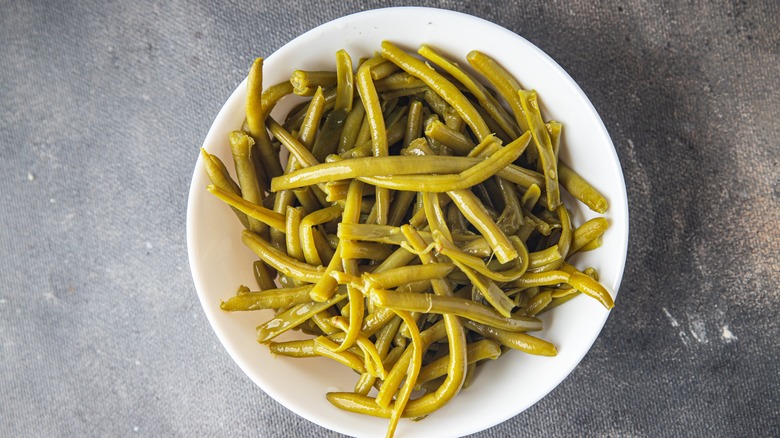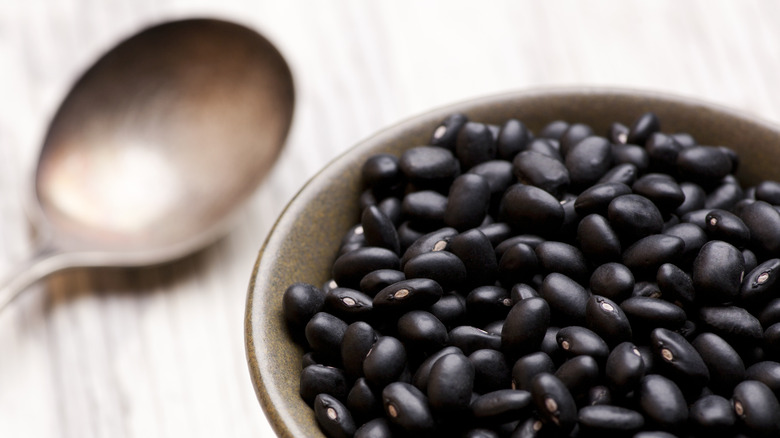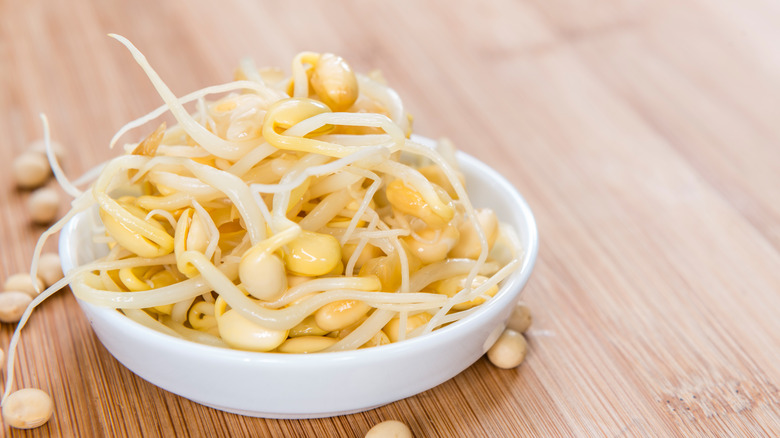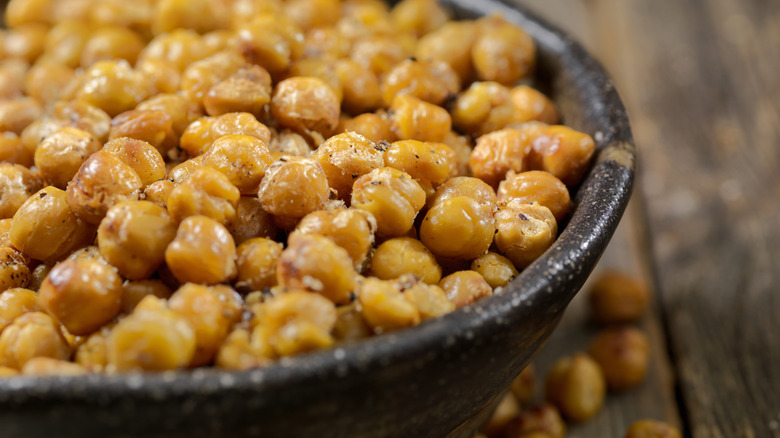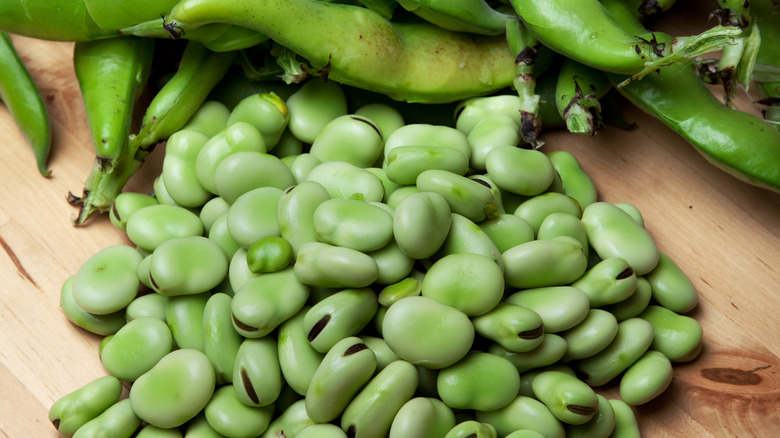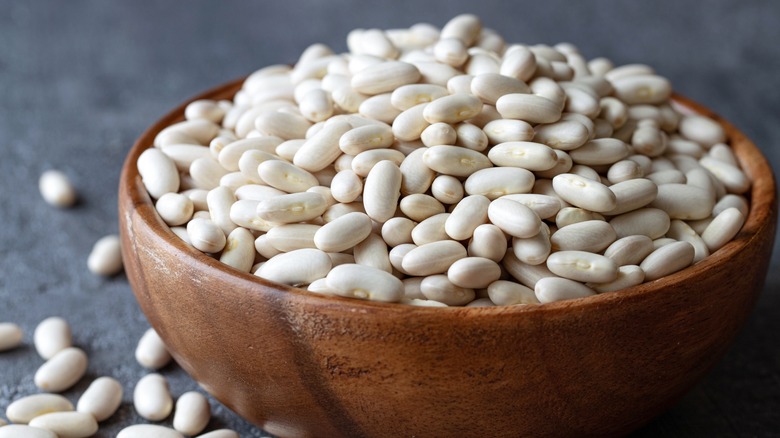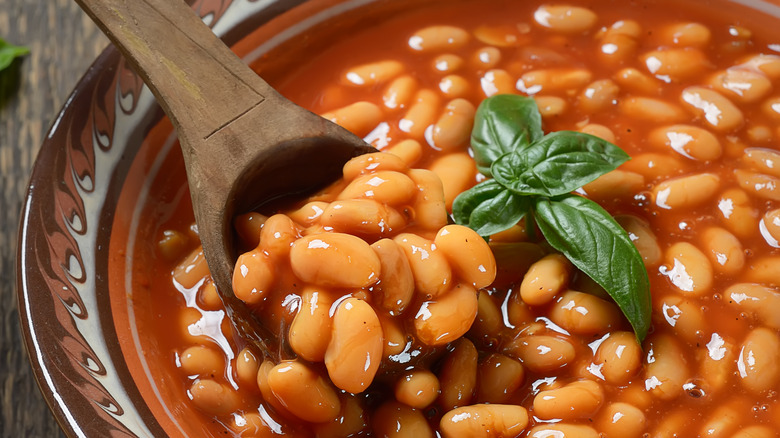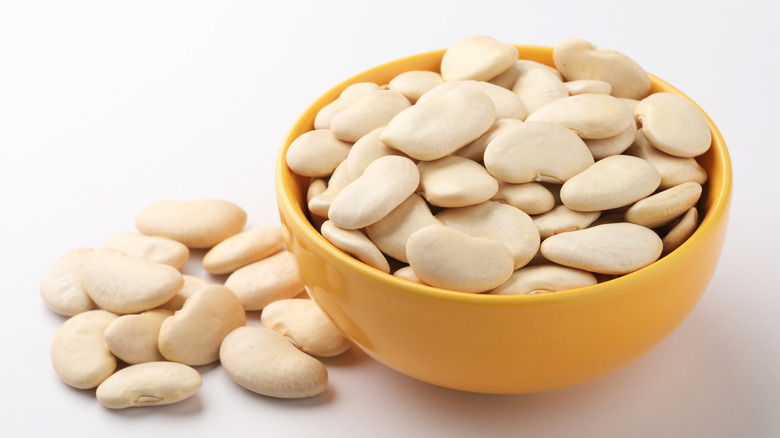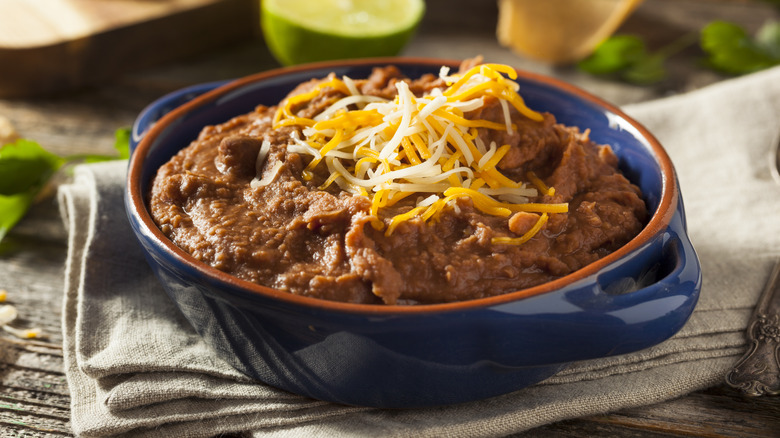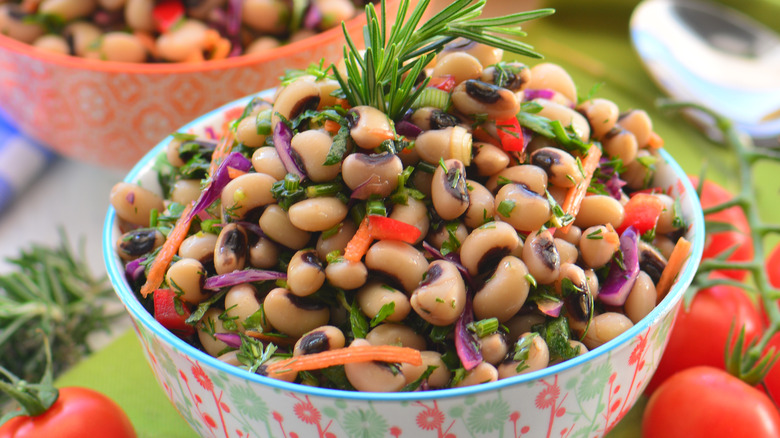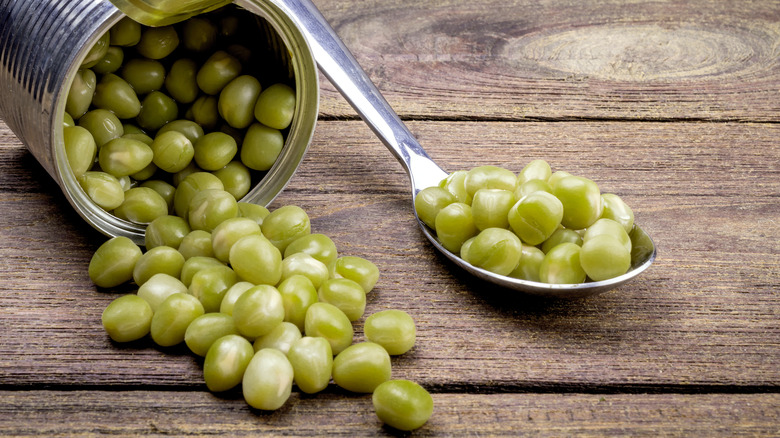6 Canned Beans You Should Buy And 6 You Should Leave At The Store
We may receive a commission on purchases made from links.
Ask any nutritionist and they'll agree: Beans are one of the absolute best foods you can include in your diet. They're high in fiber and protein and packed with an incredible arsenal of vitamins and minerals. Beans are filling, low calorie, and affordable. Psst! They also taste great and can be used in a wide variety of comfort food classics — from soups and chili to incredible sides, and even main courses.
In fact, the only thing beans don't have going for them is they can be a pain to prepare from scratch. Dried beans need to be sorted and rinsed and then soaked for hours — and that's just to get them ready to cook.
Luckily, this is where canned beans come in as potentially one of the greatest convenience foods ever dreamt up. Created in the late 18th and early 19th century as a way of keeping seasonal foods from going bad, canning revolutionized the way we eat. And with beans in particular, it meant that with the pop of a can, you could have moist, cooked beans ready to go for whatever you might be preparing.
But the process isn't perfect. While some beans take to that can wonderfully and come out of their tin ready to dig into, others are kind of a dud — mushy, flavorless, sodium-packed "has-beans" that were once healthy and delicious and now just taste like sludge. Here's how to separate those "good" canned beans from their lackluster counterparts — so you'll know what you should buy and what you can, ahem, leave at the grocery store.
Buy: canned kidney beans
Canned kidney beans are a pantry staple that everyone should keep on hand. Food historians believe than Latin America's Peruvian population may have been the first to discover the wonder of the kidney bean thousands of years ago. Named for its distinctive "kidney" shape which mirrors the kidneys in our own bodies, the popular legume is also known simply as a "red bean" in parts of the southern United States and Caribbean.
Whether you buy them pre-seasoned with chili flavors or plain on their own, canned kidney beans are a favorite of many chefs and home cooks because of their immense versatility and adding earthy nuttiness, depth of flavor, and wonderful texture to dishes.
Open a can, drain and rinse the beans, and you've got a powerhouse building block for an almost infinite number of recipes from every regional variety of cooking imaginable. Pair the beans with browned hamburger, canned tomatoes, and spices and voila, an instant starter for homemade chili. Mash the beans and you can form them into the basis of a DIY veggie burger. To take your meal in a more southern direction, pair those kidney beans with bacon, onion, chicken stock, rice, and spices and you've got the foundation for a true classic: traditional rice and beans.
You can even turn canned beans into a dessert. Many vegetarians use kidney beans as a key ingredient in everything from cookies to decadent fudge brownies.
Don't buy: canned green beans
We'll forgive you if you cave in and buy canned green beans once a year to make your father-in-law's favorite old school green bean casserole. But that recipe aside, there's no reason to ever clutter up your kitchen with tins of canned green beans. Yuck! Fresh green beans are easy to find throughout most of the year, no matter where you live in the United States.
But if you can't find fresh green beans, check the freezer aisle — those packages are still way better than canned green beans. Frozen green beans are also crisper and less mushy, stand up better as in ingredient in anything you might be cooking, and definitely taste better.
Canned green beans were once a godsend back in the day when obtaining groceries was tough and you had to stock up for a long, cold winter. But today, they're a relic that has little use outside of being a quirky Thanksgiving novelty. Hard pass!
Buy: canned black beans
Like kidney beans, black beans are popular the world over because of their taste, versatility, and nutritional value. One cup of these savory wonders pack an incredible 18 grams of fiber — more than half of what most of us need in an entire day.
Black beans are also an affordable and filling dish, perfect for use in entrees and side dishes of all types: soups, stews, salads, dips and especially in Mexican meals where this flavorful essential takes center stage. Heat and season the beans and pair them with cooked, shredded chicken or browned ground beef or pork and you've got the start for everything from tacos and burritos, to a hearty quesadilla, bean and rice bowl, or even a mouthwatering soup. Use the beans whole or smash them with a fork or potato masher to create an even creamier texture that's also ideal for bean-based dips and spreads. You can even include black beans in homemade salsa, guacamole, or chunky hummus!
And, for a truly unexpected kick of nutrition, toss a handful of canned black beans into your morning smoothie to make it more robust. Blend 1 frozen banana, 1/2 cup black beans, some pitted medjool dates, 1 cup milk, 1 tablespoon cocoa powder, and 1 teaspoon ground cinnamon for a hearty chocolate pick-me-up that's low in sugar and packed with protein and fiber. You won't even know the beans are there!
Don't buy: canned bean sprouts
Canned bean sprouts are another quirky relic well past its expiration date. If you aren't familiar with bean sprouts, all you really need to know is that they're tender, crunchy literal sprouts of the mung bean plant that have just emerged from their seed and begun to grow. They're also a staple of Asian cuisine and have been used in Chinese and Japanese cooking for thousands of years. They have a crisp, nutty, and slightly sweet flavor and can be eaten plain, in sandwiches and salads, or used as an ingredient in everything from soups to stir-fries.
Yet, despite the popularity of bean sprouts, there was a time when they were hard to come by, especially in rural areas or within population centers that didn't have easy access to an Asian market. That's how canned bean sprouts came about. But a lot has changed — international markets are now more common. And even traditional grocery stores carry a much wider variety of ingredients than they one used to — fresh bean sprouts included.
And if you still can't find fresh sprouts in your area, all you need to do is a quick Google search and you'll find dozens of tutorials on how to grow your own. So why do you need cans of these incredibly mushy, bland, processed sprouts when it's so easy to buy the real thing? You don't. This is one can you should kick to the curb!
Buy: canned chickpeas (aka garbanzo beans)
A classic ingredient in the Middle East, chickpeas are beloved in a number of regions including India, Turkey, Iran, and the Mediterranean. Because of this popularity, the humble bean can be known by a variety of alternate names, including the garbanzo bean, the bengal gram, an Egyptian pea, and the quite poetic chana dal.
Like most beans, chickpeas are an excellent source of fiber and protein — traits that also make these tasty beans a common substitute for meat in many different types of plant-based diets. With their unique creamy texture (especially once mashed) and mild earthy, nutty taste, chickpeas have found their way into a number of classic comfort foods including hummus, falafel, and curry. They also give heft and volume to fresh green salads, breakfast hashes, wraps, pasta dishes, and all sorts of "one bowl" meals.
While you could soak and boil dried chickpeas, the canned variety of the bean is infinitely faster and more convenient. And it tastes virtually the same — there's no noticeable loss in taste or quality through the canning process. That fact, combined with the incredible shelf-life you get from canned food, means just one thing: There's no reason not to stock up on these goodies and always have at least a few cans on hand for when you need them or just want to add wholesome heft and crunch to whatever you're making for dinner.
Don't buy: canned fava beans (broad beans)
If your knowledge of fava beans doesn't extend much beyond Hannibal Lecter and his penchant for the tasty legume — with "a nice Chianti" — you need to get out more. Not to see movies but instead to sample this marvelous bean that you've been missing out on.
Also sometimes known as broad beans or English beans, fava beans have a creamy, buttery texture that truly sets them apart from other beans. They're also slightly sweet with a hint of grassiness or fresh, "green" flavor. And they absorb other flavors beautifully, making them a perfect counterpart to anything they're served with.
But a lot of those wonderful qualities are dampened when the beans are canned. They can turn not just mushy but metallic tasting, losing the very traits that make them so exciting. Luckily, there's no need to buy canned fava beans. Fresh beans are widely available and in season during spring and early summer. And if you miss buying them fresh, you can always pick them up in the freezer aisle.
Either fresh or frozen, simply boil the shelled beans with a pinch of salt for two to three minutes to make them soft. Then, drain and sauté your favas with butter or olive oil until they are tender and slightly browned on all sides. It's easy, delicious, and way more satisfying than fava beans from a can!
Buy: canned white beans
Also sometimes dubbed a Great Northern bean, navy bean, or cannellini bean, the white bean is a mild, neutral flavored bean that's soft and creamy when cooked. It's ideal for mashing or pureeing into soups, dips, and spreads. And the incredible tenderness of the bean means it also blends incredibly well with lots of other ingredients, making it the ideal addition to everything from savory chili to a vegetarian sandwich. Just pop open a can and put those beans to use!
White beans even pair well with pasta — "Nonna's" classic Italian dish Pasta e Fagioli is constructed around the bean. To make it, sauté 1 chopped onion, 2 cloves of minced garlic, 1 diced carrot, and 1 stalk of diced celery in a large pot until tender. Next, stir in a can of diced tomatoes, 4 cups chicken broth and 1 can white beans that have been rinsed and drained. Let the mixture simmer over medium heat for at least 15 to 20 minutes. As it cooks, add your seasoning: 1 teaspoon oregano, 1 teaspoon basil, salt and pepper to taste. Finally, just before serving, stir in 1 to 2 cups of cooked pasta and garnish with grated Parmesan cheese. Yum!
Don't buy: canned baked beans
Baked beans are another all-American comfort food. A mixture of navy beans, kidney beans, and pinto beans combined with molasses, brown sugar, Worcestershire sauce, mustard, and tomato sauce and then slow-cooked to perfection, the dish is believed to have originated on American shores but is now beloved around the globe. (Brits and Aussies even eat it in the morning spread on toast!)
But why buy baked beans in a can? They're a highly processed mixture and often either too bland or too sweet and completely lack the wonderful essence of bacon or ham or fresh herbs that you can imbue in beans when you bake them yourself. Yes, opening a can may be faster. But the homemade variety is so much better that this is one case where taste simply outweighs convenience.
For example, did you know you can use a whole smoked ham hock to flavor a pot of baked beans, like Josh Sharkey, chef and co-owner of Bark Hot Dogs in Brooklyn's Park Slope does. Television favorite Giada De Laurentiis has her own secret technique: She elevates her baked beans with beer and molasses. You can try either of their approaches, or come up with a unique twist of your own, like added apple or nuts, a shot of bourbon, vinegar, grated cheese, or even a hefty dose of hot sauce. Whatever addition you decide on, know this: It's bound to taste better than something that came with a label!
Buy: canned lima beans
Despite their difference in color, lima beans are a cousin to the kidney bean and also first gained culinary popularity in the Latin American nation of Peru. (Fun fact: The beans are even named after the country's capital city: Lima! However, some people refer to them as either "Madagascar" beans or "butter beans" because of their incredibly moist, "butter-like" texture.)
Whatever you call them, lima beans are incredibly versatile and can be used in everything from soups and stews to salads and casseroles. And canning doesn't impact their taste or texture, so there's no need to clean, rinse, and soak dried beans when the canned variety is just as tasty.
To put canned lima beans to work in your kitchen, you might pair them with diced tomatoes, cucumbers, red onions, and a basic vinaigrette for a light salad. Or puree the beans with olive oil, lemon juice, garlic, and your favorite dried spices to create a healthy dip for chips, crackers, or vegetable sticks.
For something a bit heartier, combine those canned beans with corn, bell peppers, onions, and bacon for a classic Southern succotash. Or, use them to make a simple and insanely tasty one-pot meal. Simply sauté the canned lima beans with sausage and sliced onions and bell peppers. When everything is warm and cooked through, it's ready to serve!
Don't buy: canned refried beans
Like baked beans, refried beans are another example where homemade always tastes better than a canned version. Refried beans are meant to conjure images of a plate of warm, gooey nachos or a glistening taco, over-flowing with fresh ingredients and a mound of creamy beans peaking out the side. They aren't meant to look like the block of children's clay that plops out of the can when you buy them pre-made.
Canned refried beans are chalky, fatty, and simply lack the layers of flavor and spice (nuance, people!) that you get when you make them yourself.
Luckily, making refried beans isn't hard. In fact, you can use canned beans to do it. But start with whole drained and rinsed pinto beans or kidney beans and then do the "re-frying" yourself. Pour your beans into a warm skillet with a bit of olive oil or butter. Add some onion, garlic, chili powder, and cumin — plus a bit of water if needed — and then lightly sauté until warm and lightly toasted on all sides. Once your canned beans are "fried," simply mash them to whatever consistency you like best. You can add cheese or salsa (or hot sauce) and customize the beans to your exact liking. It's quick and tasty, and best of all: There's no Play-Doh required!
Buy: canned black-eyed peas
A favorite in states like Alabama, Georgia, and Texas in particular, black-eyed peas are an essential part of Southern cooking.They have a distinct flavor that is often described as slightly sweet and a little starchy, with just the slightest hint of bitterness. And that unique taste of the beans is actually enhanced during the canning process, making canned black-eyed peas superior to the dried version of the bean in many ways. (The "black-eyed" part of the legume's name comes from the black spot on the interior side of each bean — an "eye" peering out from the beans' otherwise pale, beige skin.)
Canned black-eyed peas form the basis for a wide range of dishes including jambalaya, chili, collard green stew, black-eyed pea fritters and, of course, Cajun or Creole gumbo. They're also the primary ingredient in "Hoppin' John." This traditional Southern dish is made with black-eyed peas, rice, and spices — plus bacon, ham, or some other form of pork. It's commonly served on New Year's Day to usher in good luck for the year ahead, and is also a great way to use up any canned black-eyed peas you might have been hoarding in your pantry.
Don't buy: canned peas
If canned green beans turn your stomach with their mushiness, then canned peas might as well be considered baby food. Think of them as yet another bean — yes, peas are a type of lentil — that definitely doesn't deserve a place in your pantry, let alone on your plate!
Fresh from the garden, peas are a crisp and sweet treat — almost like Mother Nature's form of candy. They're refreshing, vibrant, and incredibly flavorful — perfect to eat on their own or to include in decadent dishes like chilled spring pea soup, pea and bacon risotto, or pea and ricotta stuffed pasta. But toss those same fresh peas into a can, and all their magic instantly disappears. Canned peas barely have any substance — they crush with a simple stir of your spoon. They taste like metal. And they're loaded with sodium. (Or, if you buy low sodium canned peas, they basically taste like nothing.) Once again, this is a case where fresh is best. Although frozen acceptable too.
Frozen peas don't need to be blanched like fresh peas do. They're already removed from their shells. And even after a few minutes of steaming in the microwave, they're still crisp and crunchy, and packed with that delicate, mild flavor that makes peas so special — as long as they haven't come from a can!

